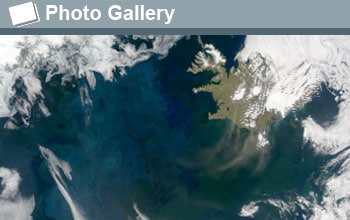The U.S. Environmental Protection Agency (EPA) announced today that it is developing an early warning indicator system using historical and current satellite data to detect algal blooms. EPA researchers will develop a mobile app to inform water quality managers of changes in water quality using satellite data on cyanobacteria algal blooms from three partnering agencies– NASA, NOAA, and the U.S. Geological Survey.
The multi-agency project will create a reliable, standard method for identifying cyanobacteria blooms in U.S. freshwater lakes and reservoirs using ocean color satellite data. Several satellite data sets will be evaluated against environmental data collected from these water bodies, which allows for more frequent observations over broader areas than can be achieved by taking traditional water samples.
Under certain environmental conditions, algae naturally present in marine and fresh waters rapidly multiply to create a bloom. Some species of algae called cyanobacteria produce toxins that can kill wildlife and domestic animals and cause illness in humans through exposure to contaminated freshwater and the consumption of contaminated drinking water, fish or shellfish. The annual cost of U.S. freshwater degraded by harmful algal blooms is estimated to be $64 million in additional drinking water treatment, loss of recreational water usage, and decline in waterfront real estate values.
“EPA researchers are developing important scientific tools to help local communities respond quickly and efficiently to real-time water quality issues and protect drinking water for their residents,” said EPA Administrator Gina McCarthy. “Working with other federal agencies, we are leveraging our scientific expertise, technology and data to create a mobile app to help water quality managers make important decisions to reduce negative impacts related to harmful algal blooms, which have been increasingly affecting our water bodies due to climate change.”
“The vantage point of space not only contributes to a better understanding of our home planet, it helps improve lives around the world,” said NASA Administrator Charles Bolden. “We’re excited to be putting NASA’s expertise in space and scientific exploration to work protecting public health and safety.”
“Observing harmful algae is critical to understanding, managing, and forecasting these blooms,” said Holly Bamford, Ph.D., acting assistant secretary of commerce for conservation and management, and deputy NOAA administrator. “This collaboration will assure that NOAA’s efforts will assist the coastal and inland public health officials and managers across the country to distribute this information to the community in an easily understandable fashion, making them more resilient to environmental events.”
“Harmful algal blooms have emerged as a significant public health and economic issue that requires extensive scientific investigation,” said Suzette Kimball, acting USGS Director. “USGS uses converging lines of evidence from ground to space to assess changes in water quantity and quality, ecosystems, natural hazards, and environmental health issues important to the nation.”
EPA is pioneering the integration of satellite data into the decision-making process, and NOAA and NASA have pioneered the use of oceanic satellite data for monitoring and forecasting harmful algal blooms. Researchers will compare new freshwater algal blooms data with satellite records of land cover changes over time to identify specific land-use activities that may have caused environmental changes linked to the frequency and intensity of observed blooms. Studies will also include how satellite imagery could be integrated into economic assessments and protecting human health.
Ocean color satellite data are currently accessible to scientists but are not routinely processed and produced in formats that can meet the needs of state and local environmental and water quality managers. The new multi-agency effort will build on previous NASA ocean satellite sensor technologies created to study the global ocean’s microscopic algal communities, which play a major role in the movement of carbon dioxide between the atmosphere and ocean, and climate change, and will yield an improved understanding of the health impacts of cyanobacteria and phytoplankton blooms in the United States.


